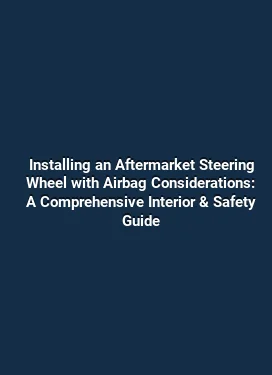How to Install a Fire Suppression System in a Track Day Car: Interior & Safety Guide
Understanding the Value of an In-Cab Fire Suppression System

Track day environments emphasize speed, precision, and reliability. A properly installed fire suppression system protects occupants and critical components, minimizes downtime, and supports compliant, safe operation on course. Modern track-ready solutions are lightweight, space-efficient, and designed to integrate with stock cabling and harness routes. When planning installation, focus on accessibility, visibility, and ease of testability. The system should respond promptly to heat or plume events, seal fuel and oil sources, and remain operable after a quick, safe reset following a fire event.
There are several system typologies to consider, including pre-engineered pull-action units and modular, field-serviceable kits. Assess your vehicle’s interior layout, firewall clearance, and rollover protection to determine optimal bottle placement, nozzle distribution, and activation wiring. The goal is a clean, non-intrusive installation that leaves interior ergonomics intact while delivering robust protection where needed most.
Key Components and How They Work
A typical track day fire suppression system comprises three core elements: a pressurized agent bottle, discharge nozzles, and a activation mechanism connected to a control system. Some setups include a manual pull handle in the cockpit, while others rely on a centralized electronic module with a direct-proportion valve. The agent type may be clean agent, water mist, or a gel-based formulation, each with trade-offs for cooling capacity, residue, and post-event cleanups. Regardless of the choice, ensure compatibility with your vehicle’s materials to avoid corrosive exposure or damage to electronics.
Nozzle placement is critical for effective coverage. In general, install at least one nozzle to protect the engine bay, another to cover the cockpit/safety cell surrounding the driver, and a third to target the fuel delivery area if feasible. The distribution should create an overlapping pattern of protection, so a single heat source does not bypass the entire system. A professional installer can provide a layout plan that accounts for hot spots specific to your engine, exhaust routing, and intake manifolds.
Interior Integration: Safety Without Compromise
Interior integration focuses on maintaining driver ergonomics, minimizing intrusion into the dash, center console, and seating area. Start by mapping the interior space to locate structural members, diagonal door bars, and the roll cage where applicable. Considerations include the length of push-pull activation lines, the accessibility of the manual pull handle, and how the system’s wiring routes through the cabin without crossing heat-sensitive electronics or critical control lines.
Mounting options should balance rigid support with vibration isolation. Use reinforced brackets, anti-corrosion fasteners, and damped mounting points to endure repeated track sessions. The activation mechanism should be reachable without requiring a driver to reach across belts or harnesses, particularly during pit stops or in the event of a fuel leak. For closed cockpit areas, ensure there is adequate sealing to prevent climate control interference or fogging around viewports during a race or track day session.
Wiring, Activation, and Electrical Considerations

Electrical integration demands clean routing and protection against abrasion, heat, and oils. Run power and activation wiring away from high-heat components, using conduits or protective sleeves where necessary. If using an electronic activation unit, verify that the control circuit includes a fail-safe, such as a dedicated ignition-switched power source that remains de-energized until the activation signal is sent. Install inline fuses and circuit breakers sized to the system’s current draw to prevent electrical fires or unintended activations.
Label all wiring and connectors clearly, and document the activation sequence for serviceability. In a track environment, a quick verification test is essential: press the manual pull and confirm audible and visual indicators, the suppression bottle pressure reads within the operating range, and the engines or electrical compartments witness no residual leakage or unexpected shutdowns. Ensure the system disables correctly after a test or an event and that the cockpit remains safe for entry and egress after discharge.
Installation Steps: A Practical, Field-Ready Approach
Begin with a thorough plan. Create a diagram showing bottle location, nozzle placement, activation points, and routing for hoses and wiring. A well-considered plan reduces installation time and minimizes rework. The following steps outline a practical workflow that can be adapted by a seasoned technician or a skilled amateur with guidance from a professional installer.
- Assess Vehicle Layout: Inspect your track day car’s interior and engine bay. Note firewall gaps, roll cage intersections, and potential interference with pedals, steering, or gear shifter. Identify a position for the bottle that minimizes exposure to heat while ensuring easy access for maintenance and recharging the system after discharge.
- Choose Bottle Size and Agent: Select a bottle capacity that matches the engine size, typical track session duration, and risk assessment for fuel or oil exposure. Common choices range from 1.0 to 2.0 liters for smaller to mid-sized engines, with larger applications requiring higher capacity. Consider the agent’s environmental impact, clean-up requirements, and post-activation residue.
- Mounting the Bottle: Use a rigid bracket system bolted to a structural element such as a chassis cross member or a reinforced panel. Include a secondary safety strap as a safeguard against vibration. Ensure the bottle is oriented to allow straightforward discharge and minimal risk of kinking hoses.
- Routing of Hoses and Nozzles: Run discharge lines to the engine bay and cockpit nozzles with gentle bends and adequate protection. Use heat-sleeved hoses near turbochargers or exhaust manifolds to prevent thermal degradation. Anchor lines to reduce movement during aggressive braking or cornering.
- Activation and Wiring: Install a reliable activation switch within reach of the driver. Route the wiring away from hot components and shield it from potential abrasion. Fuse the circuit responsibly and document the wiring diagram for future service needs.
- System Seals and Pressure Checks: Pressurize the system following the manufacturer’s guidelines. Check for leaks along hose joints, nozzle fittings, and bottle seals. Perform a controlled discharge test in a safe environment to confirm coverage and correct operation of the activation mechanism.
- In-Cabin Safety Considerations: Ensure that the installation does not impede seat harnesses, seat adjusters, or steering wheel clearance. Confirm that the manual pull handle is clearly visible and accessible in case rapid activation is needed. Verify that the system’s footprint does not create sharp edges or protrusions that could injure occupants during a crash.
Testing, Validation, and Regular Maintenance
Post-installation testing builds confidence and safety. Conduct a series of checks starting with a visual inspection, then a controlled system discharge in a controlled area under supervision. Validate that the agent covers exposed areas such as the engine bay and cockpit around the driver’s seat and pedals. After discharge, inspect for residue and ensure easy access for recharging or replacing components. Regular maintenance should include inspection of bottle integrity, nozzle cleanliness, and checking activation wiring for wear or corrosion.
In track day environments, predictable behavior matters. Schedule periodic system tests aligned with service intervals or after any event that results in an abnormal vibration or impact. Keep spare seals, hoses, and nozzles on hand and verify that the agent remains within its shelf life. Maintain a log of inspections, replacements, and test outcomes to support ongoing safety compliance and reliability on the track.
Operational Best Practices and Real-World Scenarios
Practical use cases illustrate how an interior-focused fire suppression system adds value. For example, during a high-speed session on a technical circuit, a heat source from the exhaust manifold can trigger the system in the engine bay. The cockpit nozzle ensures that any flames near the driver’s footwell or instrumentation are quickly addressed. In endurance-style track days, having a system with a larger capacity and faster activation reduces downtime and helps teams maintain competitive laps while safeguarding equipment and personnel.
Clear communication between drivers and pit crews is essential. Establish a standard protocol for what to do when the system discharges, including maintaining position, pulling to a safe area if possible, and performing post-event checks. Documentation such as a quick-reference guide placed near the driver’s seat can expedite decisions and reduce missteps under pressure.
Environmental and Compliance Considerations
Choose a suppression agent that aligns with environmental standards and local regulations. Some agents produce minimal clean-up requirements and are easier to manage in a tight paddock environment. Ensure that the system design complies with any governing body requirements for track day events, including coverage expectations and installation visibility. A well-documented installation with clear labeling reduces the potential for misinterpretation during inspections or during a post-event debrief.
Keep in mind that the interior materials and paint can be sensitive to certain agents. Whenever possible, select a system with a proven track record for compatibility with common automotive interiors and engine bays. If a spill occurs, have an absorbent kit ready and follow the manufacturer’s guidance for decontamination and disposal.
Risk Mitigation: Beyond the System Itself
Fire suppression is part of a broader safety strategy. Pair the system with a well-fitted FIA-spec roll cage, fire-resistant seat and harness, and a quick-access shutoff for the fuel pump and electrical systems. Regular driver training on how to react during a fire event complements hardware protection, reducing risk and improving response times in critical moments on the track.
Investing in high-quality components, professional installation, and thorough testing ensures long-term reliability. Regular reviews of the installation plan, especially after vehicle modifications or upgrades, help maintain protective coverage and interior accessibility. By prioritizing structured maintenance and clear documentation, a track day car can remain safe and competitive across multiple seasons.
Maintenance Checklist for Ongoing Reliability
A comprehensive maintenance plan keeps the system ready for action. The checklist includes weekly visual checks for signs of leakage, monthly test activations, and annual servicing or hydrostatic testing as recommended by the manufacturer. Confirm that all fasteners remain tight, the nozzle apertures are clean, and the activation handle operates without friction or delay. Replace any worn components promptly to prevent a failure at the worst possible moment on the track.
Record-keeping is essential. Maintain a service log with dates, inspection notes, and test results. Include a note about any environmental conditions that might affect performance, such as extreme heat exposure or corrosive residues from the agent. This practice not only supports safety but also helps planning for future upgrades or modifications to the car’s interior layout.
Final Thoughts on Interior & Safety Integration
Achieving a harmonious balance between interior comfort, driver accessibility, and robust fire protection requires a thoughtful approach to design and execution. A well-planned installation, careful component selection, and disciplined maintenance create a track day car that remains safe, functional, and ready for the adrenaline of performance driving. By integrating practical guidelines with real-world deployment insights, builders and racers can protect both people and assets without compromising the driving experience.






